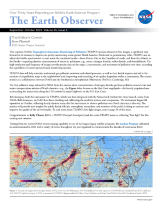The Earth Observer has a new look! Visit the NEW Earth Observer website.
The Earth Observer: Sep - Oct, 2023
In This Issue
Click title below to view page
- Feature Article
- Earth Science Highlights from the History of NASA and the Environment Symposium3
- Meeting Summaries
- South/Southeast Asia Meeting on Air Pollution in Asia—Inventories, Monitoring and Mitigation28
- Summary of the Final Activities of the 2018–2023 Landsat Science Team38
- Update on the State of CERES and Highlights from Recent Science Team Meetings43
- In the News
- NASA Shares First Images from US Pollution-Monitoring Instrument54
- Water-Watching Satellite Monitors Warming Ocean off California Coast56
- NASA Researchers Measure Sinking Land in American Samoa58
- Also Included in this Issue
- In Memoriam—Nancy Gray Maynard50
- In Memoriam—Robert J. “Joe” McNeal52
- NASA Earth Science in the News60
- Earth Science Meeting and Workshop Calendar62
The Editor's Corner
Steve Platnick, EOS Senior Project Scientist
This summer, NASA’s Tropospheric Emissions: Monitoring of Pollution (TEMPO) mission released its first images, a significant step forward in its mission to improve air quality monitoring across greater North America. Positioned in geostationary orbit, TEMPO uses an ultraviolet/visible spectrometer to scan across the continent hourly—from Mexico City to the Canadian oil sands, and from the Atlantic to the Pacific—capturing daytime measurements of major air pollutants, e.g., ozone, nitrogen dioxide, sulfur dioxide, and formaldehyde. The high-resolution and frequency of images provide precise data on the origin, concentration, and movement of pollution over time, exceeding the capabilities of current ground-based monitoring systems.
TEMPO data will help scientists understand gas pollutant emissions and related processes, as well as their health impacts and aid in the creation of air pollution maps at the neighborhood scale, improving understanding of air quality disparities within a community. The science mission is a collaboration between NASA and the Smithsonian Astrophysical Observatory (SAO) in Cambridge, MA.
The first pollution maps released by NASA from the mission show concentrations of nitrogen dioxide gas from pollution around cities and major transportation arteries of North America—e.g., the Figure below focuses on the East Coast megalopolis—the heavily populated area surrounding the major cities along the I-95 corridor (a major highway) on the U.S. East Coast.
Ball Aerospace built the instrument for TEMPO, which was then integrated with the Maxar-built Intelsat 40e. Since launch, teams from NASA, Ball Aerospace, and SAO have been checking and calibrating the satellite’s systems and components. The instrument began full operations in October, collecting hourly daytime scans, the first instrument to observe pollution over North America in this way. The mission will provide new insights for public health officials, atmospheric researchers, and members of the public looking to monitor and improve the quality of the air we breathe. To read more about TEMPO’s first light images, turn to page 54 of this issue.
Read more...

